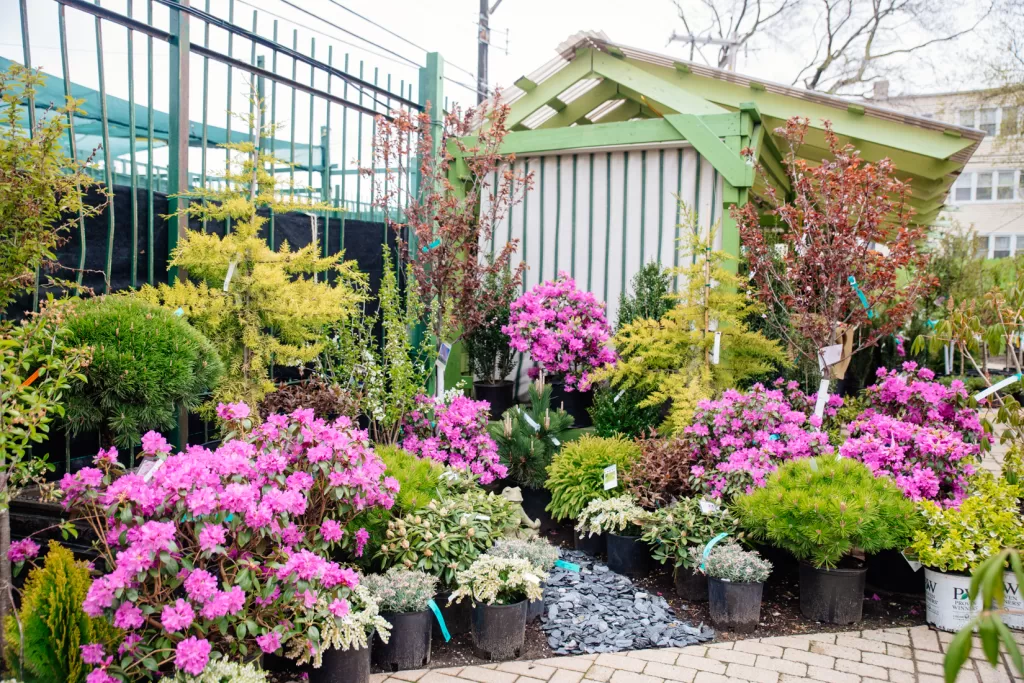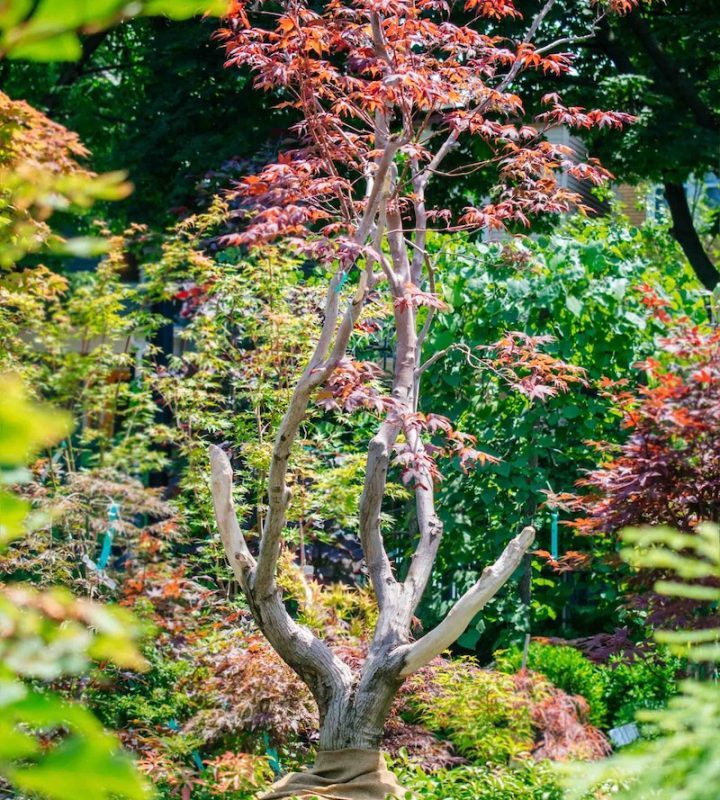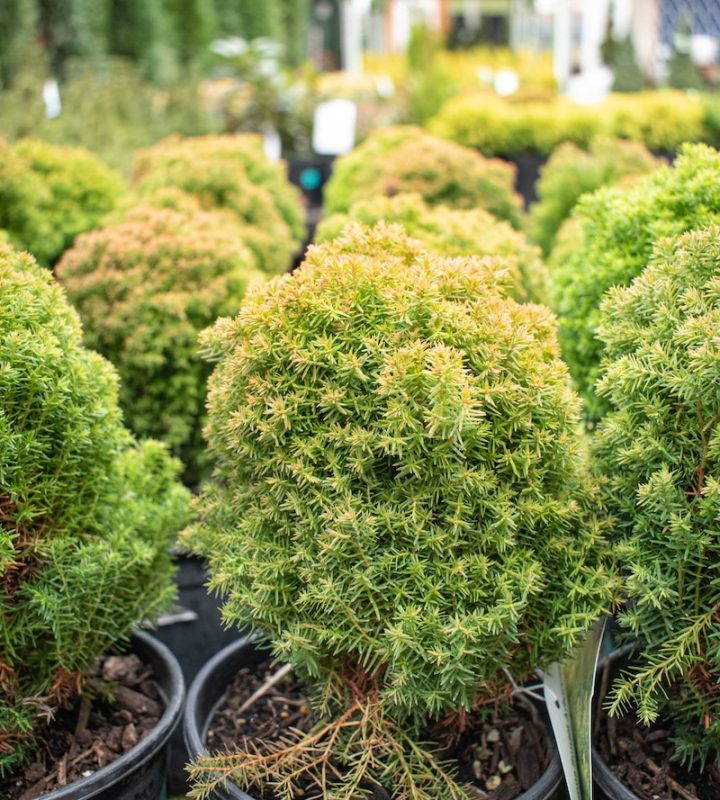Trees & Shrubs
Woody plants that are the anchor to your garden
Gethsemane’s tree and shrub lot is the premier source for Chicago’s landscaping needs. We carry a large variety of specimens specifically chosen for success in our unique climate.
treesandshrubsgethsemane@yahoo.com
773-769-8217

Common trees and shrubs we stock
While our inventory lists change from year to year, the quality of our material does not. Please note that supplies may not last, so call or email if you are interested in something specific. Our inventory changes all the time, but we always stock some tried-and-true favorites.
conifers
Plants with needle or scale-like leaves including evergreens, pines, yews, arborvitaes and more.
Ornamental & Shade Trees
Find maples, birches, dogwoods, Magnolias, redbuds and more to complete your striking landscape.
fruit trees
Apples, cherries, peaches, plums and more midwestern favorites bear beautiful blooms & delicious fruit.
JAPANESE MAPLES
Symbols of peace & serenity, with vibrantly colored leaves, Japanese Maples are a must for any foliage-loving gardener.
BROADLEAF & SHADE SHRUBS
Hydrangeas, azaleas, boxwoods, holly and more eye-catching classics.
Pest and Disease Updates
Year-to-year different pests and diseases are more common in the Chicago area. If you think your plant has been affected, we can help diagnose your situation. All plant material samples that are brought in for our review must be in a sterile Ziploc bag.
Boxwood Blight
Boxwood Blight is a disease caused by a fungal pathogen that can infect all above-ground plant parts, resulting in leaf lesions, leaf drop, stem lesions and severe dieback. Fungicides can protect plants from infection and suppress disease development, but do not cure Boxwood Blight.
Because Blight is on the rise, we are trying to make sure our stock is not at risk of infection. Our plants are sourced from growers that are part of a certification program that are inspected on a regular basis to help prevent spread.
The Illinois Green Industry Association-representing growers, nurseries, garden centers, and landscape professionals throughout the state have been working with the Illinois Department of Agriculture to establish the best approach for protecting our industry along with the Illinois landscape from this disease.
Viburnum Leaf Beetle
Gethsemane will no longer be stocking the following Viburnums due to the high susceptibility of Viburnum Leaf Beetle until further notice. Highly susceptible species are the first to be attacked and are generally destroyed in 2-3 years following an infestation. This is a relatively new insect that has been reported across the Chicago area. The insects are known to do extensive damage to plants as it feeds both during larvae and adult stages.
- dentatum, arrowwood
- nudum
- opulus var. americana, (formerly trilobum)
Have a tree or shrub that's giving you trouble?
Tree & Shrub 1-YEAR warranty policy
Plants purchased at the full retail price that fail to survive the first year will be replaced with another plant or store credit.
- Replacements will not be considered on plants that:
- have cosmetic damage alone
- that were purchased at a discounted price
- that have been planted in containers, raised beds, or parkways.
- The warranty is valid for one (1) year from the original date of purchase.
- The warranty covers 100% of the original amount paid for the plant.
- You must have a copy of your cash register receipt to activate the warranty. For your convenience please email us at treesandshrubsgethsemane@yahoo.com with a current photo of the dead plant in the ground and an image of your receipt for review.
- There will only be one replacement of the tree or shrub, or store credit issued for the dead plant material. No cash, debit, or credit card return will be issued. The replacement plant will not have a warranty.
- Delivery and planting services are not covered under the warranty.
PLEASE DO NOT BRING ANY PLANTS BACK TO THE STORE! We will not accept any returned plant material that has left the property due to the possibility of contamination. Our plants are sourced from growers that are part of a certification program that are inspected on a regular basis to help prevent the spread of disease.
Planting Tips
Planting in the ground

1) Planting
Dig a hole at least twice the width of the root ball or container.
For Ball & Burlap plants: Place the root ball in the hole, remove all ropes, and cut away the top third of the burlap and wire basket (if present).
For container-grown plants: Gently remove the plant from its container, check to see if roots are circling and wrapped around themselves excessively, and loosen them if needed. Ensure the root flare (where the topmost root emerges from the trunk) is at or slightly above soil level. Backfill with a mix of native soil and amendments, tamp the soil, and water thoroughly.
2) MULCHING
Mulch is both decorative and protective. It helps maintain soil moisture, regulates temperature, and encourages beneficial organisms. Spread mulch 4-5 feet around the plant, but keep it 4-6 inches away from the trunk to avoid rot or pest issues.
3) WATERING
There’s no set watering schedule. Check soil moisture every 24-48 hours. Water deeply when the top 2-3 inches of soil feel dry, and monitor more closely during hot or windy conditions.
4) FERTILIZING
- First Season: Avoid fertilizing newly planted trees or shrubs to allow root establishment. Compost or soil amendments can be used when planting.
- Second Season: Fertilize starting in late May. Use organic fertilizers for slow-release benefits.
Planting in containers
Container gardening is rewarding but comes with unique challenges. Trees and shrubs in containers may need to be replaced every 1-5 years due to the following issues:
- Constrained Roots: Limited space restricts root growth, increasing the chance of the plant becoming root-bound.
- Temperature Swings: The small soil mass and exposure can cause temperature fluctuations that stress plants.
- Moisture Loss: Heat, wind, and limited soil dry out containers quickly. Regular watering is essential—rainfall alone isn’t enough.
- Poor Drainage: While plants need frequent watering, they can’t sit in water. Ensure your containers have good drainage.
With extra care, your container plants can thrive despite these challenges.

1) SELECTING PLANTS
When preparing to purchase plants for a container garden, check the exposure of the area where you want to put your containers. How much sun does it get? What direction does it face? It is also helpful to take pictures and measurements of the space or draw a diagram.
2) CONTAINER OPTIONS
Our Statuary department carries many containers in a variety of sizes, shapes, and materials. Resin containers are popular because they are lightweight and hold up well to weather conditions. Heavier containers can be a good choice for high-rise buildings where intense winds can be problematic. When planting trees and shrubs, bigger containers are always better. The larger size allows for greater root growth, moisture retention, and insulation. Remember, plants may eventually outgrow the container. Also, make sure the containers you purchase have drainage holes.
3) PLANTING
Make sure the root flare (where the roots begin to emerge from the plant’s base) is at or slightly above the soil line. The soil should sit 2-4 inches below the rim of the container. You can add a 1-3 inch layer of rock or gravel at the bottom for better drainage.
Fill about ¾ of the container with high-quality potting soil, creating a funnel shape in the center. Remove the plant from its grower’s pot, gently loosening any compacted roots. Place the plant in the center, add soil to cover the roots, and press down firmly to secure it. Water immediately, and check that water is draining properly from the bottom of the container.
4) WATERING
There’s no set watering schedule. Check soil moisture every 24-48 hours. Water deeply when the top 2-3 inches of soil feel dry, and monitor more closely during hot or windy conditions.
5) WINTER MAINTENANCE
Plants in containers are much less cold-hardy, but wrapping the container in burlap or bubble wrap can protect roots. Grouping plants together (with hardiest plants on the perimeter) or against a building helps shield them from the cold.
Repeated freeze-thaw cycles in early spring can cause plants to bud or leaf out too early, making them vulnerable to frost damage. Buds and leaves are far less cold-hardy than the woody parts of the plant.
Most plants require very little water during winter dormancy, but evergreens, which keep their leaves or needles, need occasional watering to prevent dehydration. Since they lose moisture through their foliage, a good tip is to place ice cubes on the soil—these will slowly melt, providing a gentle, steady water supply.
Tree & Shrubs Resources
TREE & SHRUB GLOSSARY
Balled and Burlapped – “B & B” plants are grown in the ground. Once they are dug from the ground, their root ball is wrapped in burlap (and, often, a wire cage) and then prepared for sale. Larger, more mature plant specimens can be available in this manner.
Bare root – Plants have been uprooted and soil removed from the roots while dormant. Not all plants are available in this form. It is commonly used for roses, fruit trees, some shrubs, and perennials. Bare root material has a very limited availability and planting time. Bare root plants are a perishable commodity – get them in the ground as soon as possible.
Broadleaf evergreen – Plants with leaves, which retain them year-round. Common examples are
rhododendrons, boxwoods, and many hollies.
Caliper – A nursery measure of trunk diameter, usually at twelve inches above the ground.
Conifers – Cone-bearing plants. Not all conifers are evergreen, but most are. A large group of plants that include pines, spruces, firs, junipers, Arborvitae, yews, and many others.
Container stock – Plants grown and sold in containers. Container-grown plants are in soil mixes that are lighter than native soils: this makes them easier to ship and handle. The lighter soil mix also means that they will require more regular watering to get established.
Deciduous – Plants that shed their leaves at the end of the growing season. Most of our woody trees and shrubs are deciduous.
Dormancy – Dormancy is the period in a plant’s life cycle when it enters a period of rest. Most plants enter dormancy during the cold winter months.
Mycorrhiza – Fungi that grow on or around the root system of a plant. The fungi absorb nutrients such as phosphorus and magnesium and bring it directly to the plant roots. Mycorrhizae can help protect their plants against diseases and toxins. They can also serve as a sugar delivery service for different plants connected to the same common mycorrhizal network. Mycorrhizae naturally occur in healthy soil, but can also be found packaged or in a quality fertilizer.
Root flare – The root flare is the place where the topmost root emerges from the trunk. It should always be at or above soil level. Plants with the root flare buried too deep can have multiple health problems.
Variegated – Plants that have more than one color in the leaf, and sometimes the stem. Variegated plants can help break up large blocks of solid green foliage.
Should I fertilize my trees/shrubs after planting or transplanting?
First season: When planting a new tree or shrub, do not add any fertilizer. The tender root system of your new specimen will need to re-establish itself first. However, compost, or another soil amendment may be added during planting.
Second season: Due to unpredictable late winter/early spring weather, we strongly recommend to wait until the 3rd week in May to apply fertilizer. Organic fertilizers, which break down more slowly, can be applied in early April.
When should I prune my trees/shrubs?
It depends on the plant: some can be pruned in early spring while others may benefit from fall pruning. If you need help determining what your plant needs, please come to the Tree & Shrub department and we can assist you. Make sure you know the variety of plant you are pruning, or bring pictures or samples (in sealed plastic bags) so we can identify it.
Plants should be pruned to maintain health, size and shape, along with improving flowering and fruiting. Dead or diseased branches should be removed first, then you can proceed to prune for shaping, rejuvenation, or promoting fruit.
Plants that have buds set on old growth like forsythia or lilacs should be pruned after flowering. Plants that bloom on the new growth can be pruned early before the season starts and any sign of new life is visible. All evergreens other than pine should be pruned before the new growth starts in spring or during mid-summer when the growth stage is not active.
why won’t my plant flower?
It is sometimes difficult to determine just why a particular plant will fail to set flower buds, or will set them and not develop flowers. There may be several reasons: too much fertilizer (high nitrogen); not enough sun; pruning at the wrong time; cold or drought stress; or the plant is not sufficiently established. The above mentioned conditions will account for the majority of reasons why a woody plant may not produce flowers during a particular season. It is important to keep in mind that plants are complex organisms and that flowering is controlled by many factors in the environment. Good plant selection, proper planting and care, site selection (and sometimes, patience) are elements to successful flowering. Sometimes, in spite or all you do, some plants just refuse to flower for a season.
When is the best time to transplant my shrubs?
Many plants can survive transplanting any time during the year when the ground is not frozen, but woody plants are best moved in the spring after the ground thaws and before the buds on the tree or shrub begin to swell. They may also be moved in the fall after leaf drop but before the ground freezes. Fall planting should take place soon after leaf drop, providing time for new water absorbing roots to develop before the soil freezes. Evergreens are especially prone to winter browning if planting is delayed until shortly before the ground freezes in the late fall, they should be moved in the late summer to early fall. Fall transplant success may be increased by transplanting hardy plants into sites with good soil moisture and wind protection.